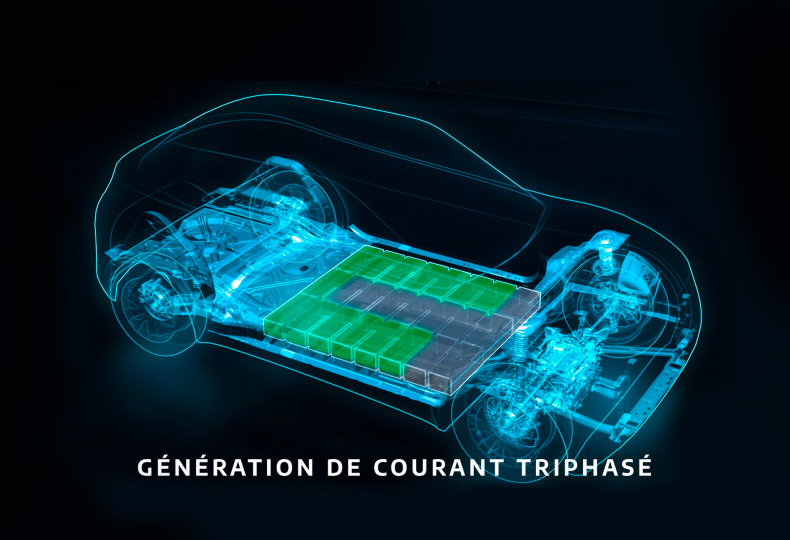The IBIS project: exemplary cooperation for revolutionary batteries

A joint research project
- A joint research project between two major manufacturers, three CNRS joint laboratories (GeePs, SATIE, LEPMI) and the Lafayette Institute, and two SMEs (E2-CAD and Sherpa Engineering),
- A prototype that integrates the functions of the charger and inverter into the lithium-ion battery modules using modular electronic conversion boards, and already the prospect of marketing a breakthrough technology in mobile and stationary energy storage by the end of the decade...
- The scope of the IBIS (Intelligent Battery Integrated System) project goes beyond the development of a more efficient and less costly energy storage system. Its exemplary nature owes much to human intelligence, to the relationships of trust and mutual respect forged in the research field, and to the informal exchanges that give rise to crazy ideas.
- The fact that it took the IBIS researchers and engineers 'just' four years to develop an intelligent battery is due in part to the research work launched in 2011 by Bertrand Revol and Denis Labrousse, two teacher-researchers from the SATIE UMR8029 electrical engineering laboratory, and Gilles Feld, now deceased, associate professor of electrical engineering in the Department of Electronics, Electrical Engineering and Automation (EEA), now the Nikola Tesla Department of Education and Research (DER).
The origins
"One of the advantages of the battery of the future is that it capitalises on an available power converter technology, the Modular Multilevel Converter (MMC). This type of modular multi-level converter, designed to transform direct current into alternating current on high-voltage networks, was in the process of being widely industrialised. Bertrand Revol, Denis Labrousse and Gilles Feld took an interest in it. With the support of a PhD student from the Laboratoire des Méthodes Formelles (LMF, formerly LSV), they defined an innovative control law that balances the load on capacitors," explains François Costa, director of SATIE.
Their work was unveiled in 2013 at the Electric Power Engineering (EPE) Conference. An initial article was published. Another idea emerged from the discussions between the three scientists who were working together at the École: to transpose their control law to the power supply of an electric motor.
The GeePs laboratory at CentraleSupélec is currently working on a thesis on the optimisation of electric powertrains. The PhD student is Francis Roy, project manager for electric vehicle powertrains at PSA, now Stellantis. His track record includes leading the GENEPAC and FiSyPAC fuel cell vehicle projects. His thesis is part of an original scheme set up by Sylvain Allano, then Director of Science and Future Technologies at the automotive group, to give managers in positions of responsibility the opportunity to obtain an "executive doctorate". Sylvain Allano is a graduate of the Ecole Normale Supérieure who headed SATIE from 2001 to 2006... It was he who directed Francis Roy to GeePs, headed by Claude Marchand. Francis Roy has had an office there since 2012. His thesis opened up new horizons for him.
"I told Claude Marchand that I wanted to go further and set up an Open Lab with GeepS. He was keen, but we still needed Sylvain Allano's approval. Sylvain agreed, on condition that SATIE was involved," recalls Francis Roy, director of the Open Lab and in this capacity responsible for the scientific coordination of Stellantis' research partnerships in the field of electrical engineering applied to mobility.
The best of two worlds
The first meeting on the Open Lab project took place in November 2015. Around the table were Bertrand Revol and Denis Labrousse from SATIE, Éric Labouré and Claude Marchand from GeePs and Francis Roy.
"We had to justify the breakthrough research topics for which the Open Lab would be an accelerator. SATIE was working on how to integrate the functions of the inverter and charger in a battery with Adrien Dittrick, a student from the Ecole Normale Supérieure who was doing an M2 course in energy physics and engineering. I saw the industrial potential of such work", explains Francis Roy.
Everything followed very quickly. The Open Lab was created in 2016. Two patents involving PSA, CNRS and ENS were filed in February and November 2017 on the central ideas of the IBIS project. Adrien Dittrick joined the structure to carry out a thesis, using real data from the automotive industry for his calculations. The industrial objective is clearly to serve the necessary transition in transport and energy. A maturity dossier has been co-constructed and submitted to obtain funding from ADEME as part of the France 2030 investment programme. In 2019, the IBIS project was officially launched with a budget of €9.7 million, €5.4 million of which was funded by the French government.
What happened next is well known. "Researchers contributed their knowledge to an Open Lab supported by an industrial company, without which the IBIS project would not have been possible. From a level 1-2 research project on the TLR (Technology Readiness Level) scale, we have moved up to level 4, soon to be 5, by doing some great science. IBIS has enabled us to fund several theses and new equipment", observes François Costa, a member of the Open Lab steering committee. The complementary skills of industry and research laboratories are at the heart of this project's success.
"On this type of ground-breaking project, it's easy to motivate the teams. They are an extraordinary strike force. Everyone wants to succeed. The communication we've put in place, the experience we've gained on the fuel cell, and the use of the TRIZ creativity method, which has already been tried and tested, all encourage emulation. Skills are gradually being developed. Each person is training the others in his or her own field, so that we can strive for excellence and move closer to industrialisation," says Francis Roy.
IBIS continues. As for the Open Lab, the agreement between Stellantis and the three laboratories (GeePs, SATIE and L2S) has already been renewed in 2020 for a further four years.
